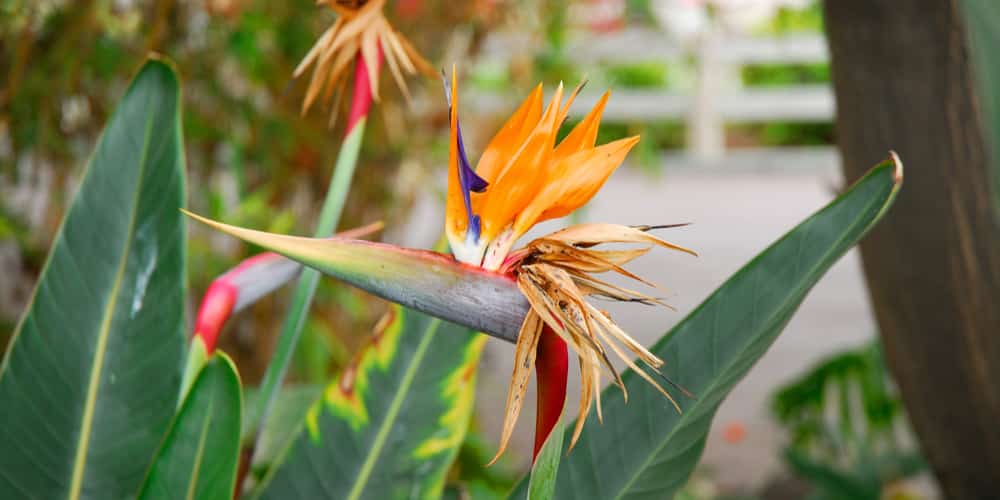The bird of paradise is a large flowering plant with enormous leaves that normally stay firm, healthy, and evergreen. However, there are times when the supposedly evergreen leaves turn yellow and fall off. If the leaves of your bird of paradise are drooping or falling off, the first culprit is water shortage — the bird of paradise needs adequate water to stay in good shape.

When this ornamental plant gets little water, its leaves will droop, turn yellow and eventually drop off. The entire process, from drooping to dropping leaves, is the plant’s mechanism to reduce the amount of water lost through transpiration.
Even though drooping of leaves helps the bird of paradise minimize water loss, it leaves the plant with very few leaves, which makes it less beautiful.
To revive the plant, it is essential first to identify the cause of drooping and how to save the plants. This article will help you identify the causes and remedies of drooping in bird of paradise plants.
Reasons why the bird of paradise droops its leaves and how to handle each cause
Many circumstances will make plants have drooping leaves. Most of these causes are the same in other leafy plants.
1. Inadequate water
Adequate water is an essential requirement for the good health of many plants, especially those plants with broad leaves like the bird of paradise. For first-time gardeners, bird of paradise plants need more water compared to many other common house plants. This is because large leaves have a large surface area for transpiration.
To know if drooping is due to inadequate water, push your finger through the soil to check if the soil around the plant is moist. If it is dry, inadequate water is most likely to be the cause of your bird of paradise drooping.
Solution
Water your bird of paradise plants occasionally, particularly when the top 2 inches of soil get dry.
2. Older Leaves
The leaves of the tropical evergreen bird of paradise get to a point where they droop and fall off due to age. Aging is a normal growth process, so you should not worry too much when the leaves droop due to age.
Notably, if drooping is due to age, the leaves tear into thinner pieces to allow wind to blow through them without breaking the plant.
Solution
Prune off the dying leaves, so the plant regains its beautiful evergreen firm state.
3. Transplant shock
Transplanting or repotting introduces birds of paradise to new soil conditions and probably new growing conditions. Drooping after transplanting indicates that your plant is trying to adjust to the new environment and will settle to normalcy in a short time.
Solution
Watering more frequently can help the plant adapt quickly to the conditions.
4. Check the Light
The bird of paradise plant loves adequate light, at least six hours of sunlight exposure daily. When you realize your supposedly evergreen plant is drooping, it is important to check on the amount of light reaching the place where the plant is situated.
Solution
If your bird of paradise is potted, moving it to a sunny spot or near a window could help it recover. On the other hand, consider transplanting to a place that receives more light if the plant is growing in your garden.
5. Overwatering
Even though birds of paradise have higher water requirements, it doesn’t mean they can grow in soggy soils. They are tropical plants.
Check if your growing pot has adequate drainage holes and whether the holes are open or blocked. Bird of paradise reacts to overwatering by dropping leaves, which eventually turn yellow, and the stems get mushy.
Solution
Check on the weather conditions before you start watering your plant. Do not water during the rainy season or when temperatures are low and humidity is high. The best way to ensure you are watering your potted plant properly is by doing a prior soil test before you water it. Watering should be done when the soil is dry, about 1-2 inches deep.
6. High temperatures and extreme cold
High temperatures quickly drain excess moisture from plants through their leaves, decreasing turgor pressure. When the turgor pressure is low, the leaves will eventually droop because the leaf cells will lack support to remain firm. Extreme cold and frostbites also damage plant tissues and cell walls, making the leaves of these tender plants droop and die off if not saved.
Solution
Take the plants indoors when the temperature falls below 13 degrees Celsius. Keep the plants away from direct sources of heat and cold air.
7. Inadequate nutrients
The bird of paradise benefits from a steady and adequate supply of nutrients — enough nutrients make them greener and healthy. However, when there are fewer nutrients in the soil, it will start showing unhealthy signs. In the long term, your plants will droop when they lack manganese, nitrogen, or iron.
Solution
Repot your bird of paradise plants every 2 or 3 years. The new soil will provide them with enough nutrients. You can as well apply a well-balanced fertilizer to the plants.
Bird of paradise drooping: Conclusion
Drooping of the large leaves of the bird of paradise plants makes it lose its beautiful color and firmness. If you realize your bird of paradise plant is drooping, you will need first to identify the reason for dropping so that you can save the plant.
Related Article: Flowers That Look Like Birds